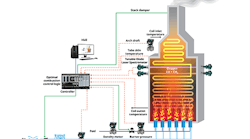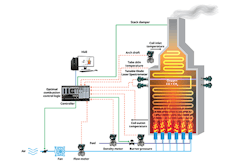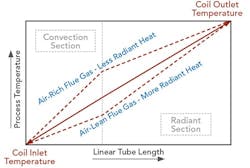Optimize Combustion Using A Digital Twin
Fired assets such as boilers, furnaces and heaters represent major opportunities for performance improvements at process plants. New developments in technologies ranging from process analyzers to advanced analytics and, most recently, digital twins can significantly assist in optimizing these assets.
Plant process operators are realizing benefits such as increased energy efficiency, reduced emissions, higher quality, improved safety and less unscheduled production downtime. In addition, they are gaining asset management and lifecycle benefits through protection of equipment and component investments. Most of the benefits directly impact the bottom line, providing justifiable return on the investment (ROI) plus lower operating costs over the long term.
In the wave of disruptive technologies that recently have come on the scene in the process industries, the digital twin potentially could be the most powerful. It is a virtual digital copy of a device, system, human or process that accurately mimics actual performance in real-time. A digital twin is executable and configurable. It operates in the present, mirroring the actual physical entity but with full knowledge of its historical performance and an accurate understanding of its potential in the future.
A digital twin replicates real-world events and actions by combining live inputs from sensors on the physical asset with historical performance data. Digital twin technology relies on a first-principles model, with the physical process feeding input into the model, which then uses those data to generate an accurate digital representation of the real-life event.
The digital twin concept encapsulates a broad set of dynamic but intangible interactions occurring within and around the physical asset, such as fluid flow, heat and material balances, yield and energy inputs/outputs, thermodynamics, human operator behaviors and other factors. These interactions are critical for asset performance management and maintenance of facilities within optimum operating windows for safety, reliability and profitability that provide optimum integrity.
Unlike advanced statistical models, even including those using artificial intelligence (AI), the first-principles model incorporates physical properties. The model is the same as those used in process simulators.
However, unlike a simulator, the digital twin accurately represents the asset over its complete range of operation and entire lifecycle, rather than just for a particular operating case. Instead of the static provision of a snapshot in time, the digital twin captures the full history and future of an asset. It operates in an automated manner, making regular model runs that are incorporated in business workflows. The digital twin provides a centralized, single version of the truth, with outputs delivered directly to all interested personnel.
A digital representation’s ability to process enormous amounts of data into understandable formats enables better decision-making for manufacturing processes; real-time monitoring, forecasting and optimizing; and predictive maintenance — while ensuring that performance of a process meets or exceeds expectations.
Scenario Testing And Far More
A key feature of a digital twin is its ability to test scenarios. Data consumers can use a digital twin to experiment with various scenarios and assess the outcomes and impacts of each without any real-world risk. Users can run “what if?” scenarios up and down the supply chain and manufacturing process to determine which strategies maximize profitability.
Process modeling allows a digital twin to identify potential safety and reliability vulnerabilities. By streamlining safety processes and improving predictive maintenance, a digital twin reduces the risk of employee injuries, environmental contamination and damage to the facility.
These aspects particularly suit assets such as boilers, furnaces and fired heaters. For example, a control system operations team created a digital twin to test the key factors influencing fired heater control and evaluate potential improvements. The digital twin modeled a fired heater in a continuous catalytic reforming process with single-fired tubes in three radiant sections.
The team used the digital twin to test scenarios related to excess air control, fuel composition changes, downstream pressure and temperatures, feed composition and rate, and heat distribution between the convection and radiant sections, among others, to assess their impact on daily operations.
A digital twin also can optimize energy management, emissions compliance and predictive asset management for fired heaters. In addition, it can work in conjunction with other digital twins to optimize the entire process and enterprise value chain. The digital twin regularly executes and updates the model with live information from the actual fired asset.
During initial configuration, the engineering team loads the model with as much historical information from the asset as possible. Going forward, the digital twin will continually compare actual operations with the history and report on parameters trending away from their optimal states or values. It also will check parameters versus limits, and warn about impending problems such as deteriorating asset components.
The digital twin can adapt as live conditions change. For example, it can automatically respond to altered fuel composition by adjusting the air/fuel ratio control. This requires the control system to accept a download of the new setpoint from the digital twin, which could reside in the Cloud. Given cybersecurity measures, plant operations will need to provide for a setpoint change from the Cloud in standard operating procedures. Some operations will have to rely on manual operator intervention or, as an alternative, run the digital twin on premise.
Key Considerations For Fired Heaters
Excess air control is perhaps the most important control system function for fired assets. Heater efficiency, emissions and safety strongly depend on the excess air volume. Unused fuel poses a safety hazard; so, to ensure complete combustion, operators typically provide more combustion air than theoretically required. However, an unnecessarily high air volume results in excessive fuel consumption, high CO2 and NOx emissions, and reduced production efficiency.
The air/fuel ratio is burner-specific. Setting the ratio correctly requires taking into account the burner properties, fuel composition and particular operational conditions.
Because tunable diode laser spectroscopy (TDLS) technology can directly measure the amount of oxygen (O2) in the radiant section of a fired heater on a 2–4-sec. cycle, the digital twin uses the amount of oxygen instead of the excess air for reference (Figure 1). Normally, a slight variation of excess air exists for different fuels.
Figure 1. Use of TDLS technology enables a digital twin to quickly respond to a change in air/fuel ratio.
The digital twin improves upon the trial-and-error process that operators often use to find the optimal excess air volume. A holistic approach, which applies considerable experience to combustion control, will include carbon monoxide (CO) trim control and use the CO breakthrough point to determine the optimal excess air volume. This breakthrough point is unique for every fired asset and depends on burners, fuel composition and furnace pressure. The digital twin is able to assist in automating the process of ascertaining the CO breakthrough point.
Petrochemical plants that use a mixture of natural gas and processed gas as fuel face an added wrinkle in air/fuel ratio control. The fuel’s composition can fluctuate considerably. Common components include butane, butylene, methane, ethane and ethylene. To evaluate the potential impact of fuel composition fluctuations, a digital twin can assess natural gas and up to five different mixtures of light hydrocarbons. Those scenarios can establish a matrix for air/fuel ratio control setpoints based on fuel composition.
A digital twin is control-system agnostic as it can supply this and other information to practically any system. By accounting for all the physical phenomena and lifecycle dynamics in the asset, the digital twin offloads those responsibilities from the controllers, removing the need for custom programming.
Digital twins have produced results with bottom-line impacts. Applications at more than ten European installations demonstrate a reduction in O2 level to 1% in flue gas for refinery gas and 2% for a combination of oil and gas. Depending on heater design and operating conditions, fuel consumption was cut by 0.6–4.2%. Additional savings could accrue from stabilizing the coil outlet temperature. Further scenario runs showed an extra 2–6% decrease in fuel consumption was achievable.
More Factors
Another issue is that the feedstock composition can vary. When the feed is in line with desired throughput, changes in the outlet temperature and behavior of the process flow controller can cause additional disturbances. Variations in the inlet temperature of the feed can create further ones. Altogether, feed rate and composition affect stability, safety and energy efficiency across the entire process.
Effects that operators sometimes overlook include downstream pressure and temperature. In a downstream process unit, a higher temperature increases the pressure in the process and, in return, influences evaporation inside the heater tubes, thus causing an additional disturbance to combustion control.
For units such as vacuum heaters, it’s important to consider the temperature distribution along the tubes in the radiant and convection sections (Figure 2). A higher volume of excess air results in higher absorbed heat in the convection section, increasing the crossover temperature.
Figure 2. The temperature profile inside the tubes of a vacuum heater changes depending on air level in flue gas.
Stabilized coil outlet temperature and O2 content in flue gas lead to substantially fewer trips and increased asset life. For fired assets such as steam methane reformers that utilize catalyst in the tubes, trip avoidance can be critical to extending the life of the catalyst and delaying an extremely expensive catalyst-change turnaround.
Sophisticated control systems use holistic approaches by applying extensive knowledge and experience to account for feed composition, downstream pressure and temperature effects, and heat distribution between the radiant and convection sections of the fired asset. This can help balance burners, equalize loading and smooth out temperature peaks.
Balanced burners reduce maintenance costs and allow longer run times between turnarounds. Balancing the burners and stabilizing the coil outlet temperature equalize the load and slow the aging of all radiant section components.
Less coking results in savings in fuel and maintenance costs. Stabilized combustion decreases tube deposits, which accelerate at high temperatures. By smoothing out temperature peaks, fired asset operators reduce the amount of decoking and maintenance required.
In addition to simplifying controllers by eliminating custom code, a digital twin provides the benefit of tracking all fired asset operations over time. It can adjust to dynamics such as aging pipes that affect flow rates. It also can inform predictive maintenance by sending rich information to a predictive maintenance application.
Also, over the fired asset lifecycle, the digital twin can ensure compliance with regulations and standards such as NFPA 87 “Standard for Fluid Heaters” by tracking parameters that indicate trending toward non-compliant performance.
Potential Digital Twin Issues
A digital twin isn’t a “quick fix” remedy. Operators wishing to rapidly improve a few key performance indicators typically can do so simply by upgrading instrumentation or enhancing control strategies. A digital twin is best for achieving continuous improvement over the lifecycles of assets and plants.
Because the digital twin uses a first-principles model with deep knowledge in terms of physical properties, its setup time can exceed that of an analytics approach such as AI or machine learning (ML), which operates purely on data sets without regard to physical properties. A digital twin requires more tuning to take advantage of deep knowledge.
A digital twin performs best with rich information. Poorly managed, inconsistent information sent to a digital twin could undermine the quality of its output. The digital twin won’t present a hazard but could provide a less-than-optimal outcome. Given incomplete information, the digital twin could fare no better than a simpler and less expensive option.
How It Compares
Because the digital twin works in conjunction with a control system, comparing it against control or burner-management systems isn’t relevant. By offloading all physical phenomena and lifecycle effects, the digital twin can simplify a control system by eliminating custom code, easing selection of a controller in a manner that’s manufacturer-independent.
A variety of advanced process control (APC), multivariable control, model-free and model-based systems have successfully addressed combustion control. These technologies provide stability that improves energy efficiency. Dynamic process models can increase throughput, conserve energy and reduce quality giveaway. These approaches do require attention to the cycle time, which could result in the necessity for rapid disturbance response, for example, to a CO excursion. Typically, approaches such as APC don’t sufficiently consider fired heater safety by running the heater with minimum excess air.
A digital twin often is compared with data analytics using AI. While a digital twin incorporates one aspect of AI technology that allows automatic improvement from experience, key differences exist between a digital twin and contemporary AI applications such as ML. While ML algorithms observe asset behavior patterns and correlate them with outcomes, they lack the deep knowledge of the underlying physical properties that are fundamental to a digital twin.
For example, given information such as pressure, temperature and the composition of fluid flowing through tubing, a digital twin can model degradation in the tubing over time, while an AI/ML approach would need to infer trends from empirical information. Lack of availability of this sort of information is a common problem.
Consider A Digital Twin
A digital twin accurately mimics the actual performance of a device, system, human or process in real-time. It operates in the present, mirroring the actual physical entity but with full knowledge of its historical performance along with an accurate understanding of its potential in the future.
For a fired asset, the digital twin encapsulates a broad set of dynamic but intangible interactions occurring within and around it, such as fluid flow, heat and material balances, and thermodynamics. These interactions distinguish a digital twin from technologies such as APC and AI/ML, and are critical for asset performance management and maintenance of facilities within operating windows for safety, reliability and profitability that offer optimum integrity.
The digital twin provides the ability to test “what if?” scenarios and assess the outcomes and impacts of a multitude of approaches without real-world risk. Scenarios run by the digital twin typically produce justifiable ROI in areas such as energy efficiency, reduced emissions and increased asset lifespan. Key additional benefits include safety improvements.
A digital twin also can offload all physical phenomena and lifecycle effects from a control system, simplifying its operation by removing required custom code. Unlike a control system, the digital twin provides for asset sustainability, continual optimization and, therefore, recurring ROI over the lifecycle.
KEVIN L. FINNAN is a Goshen, Ct.-based industry marketing consultant at Yokogawa Corp. of America. Email him at [email protected].



